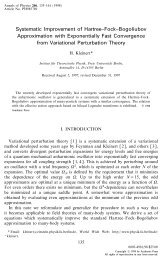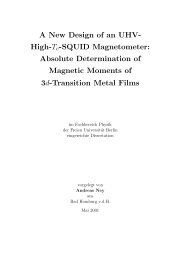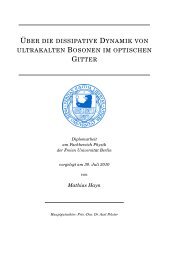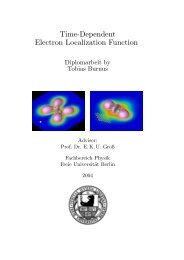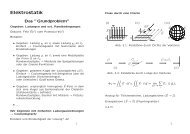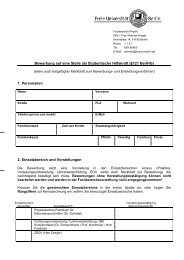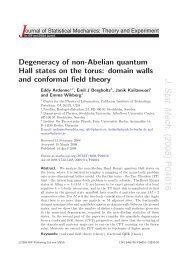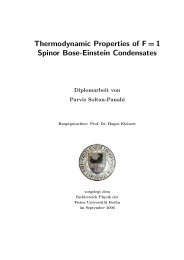Diploma thesis
Diploma thesis
Diploma thesis
Create successful ePaper yourself
Turn your PDF publications into a flip-book with our unique Google optimized e-Paper software.
4 Complex harmonic potential<br />
which coincides with the energy in (4.47). Next we derive an expression for the normalization<br />
constant in the real limit. For this purpose we also set a 1 = a 2 = −n in (4.45) and conclude that<br />
all terms containing Γ (a 1 ) −1 vanish and thus R s = 1 from (4.34). Furthermore all infinite sums<br />
including (−n) ν now have n as their upper summation index, since we have (−n) ν = 0 for all<br />
ν > n. Finally there only remains<br />
|N s |=<br />
{ n<br />
∑<br />
µ,ν=0<br />
[<br />
1<br />
µ!ν!<br />
which reduces to<br />
(−n) ( ν (−n) µ<br />
1<br />
( 1<br />
2)<br />
2)<br />
ν<br />
µ<br />
[ (<br />
Γ µ+ν+ 1 )<br />
−Γ<br />
(µ+ν+ 1 )]<br />
2<br />
2 , ω2<br />
+ (−n) (<br />
ν(−n) µ<br />
1<br />
( 1<br />
2)<br />
2)<br />
ν<br />
µ<br />
Γ<br />
(µ+ν+ 1 ) ]} −1/2<br />
2 , ω2 , (4.53)<br />
⎧<br />
⎪⎨<br />
|N s | =<br />
⎪⎩<br />
n∑<br />
µ,ν=0<br />
Taking into account (4.41) we obtain<br />
1<br />
µ!ν!<br />
(−n) ( ν (−n) ( µ<br />
1 1<br />
2)<br />
2)<br />
ν<br />
µ<br />
(<br />
Γ µ+ν+ 1 ) ⎫ −1/2<br />
⎪ ⎬<br />
. (4.54)<br />
2 ⎪ ⎭<br />
{ ∫ ∞<br />
∣ ( ∣∣∣<br />
|N s | = e −χ2 1F 1 −n, 1 )∣ ∣∣∣ 2 −1/2<br />
dχ}<br />
−∞<br />
2 ; χ2 , (4.55)<br />
∣ (<br />
where we used the symmetry of e −χ2 ∣1 F 1 −n,<br />
1<br />
; 2 χ2)∣ ∣2 with respect to χ = 0 in the last step to<br />
expand the integral over the whole real axis. With the definition of the Hermite polynomials<br />
(4.48) we can write for this integral<br />
|N s | = (2n)!<br />
n!<br />
{∫ ∞<br />
−∞<br />
} √<br />
−1/2<br />
e −χ2 |H 2n (χ)| 2 (2n)! 1<br />
dχ = √<br />
n! π2<br />
2n<br />
(2n)! , (4.56)<br />
where we used the calculation of the integral from [29, Chap. 35].<br />
Taking the real limit a 1 = a 2 = −n of (4.35) yields directly one and the same form in all 3 areas<br />
ψ s 0 (χ) = N s e − 1 2 χ2 1F 1<br />
(<br />
−n; 1 2 ; χ2 )<br />
. (4.57)<br />
Now we insert the absolute value of the normalization constant (4.56) into the general expression<br />
(4.46), so that we can write for the wave function<br />
which reduces with (4.48) to<br />
ψ0 s (χ) = (2n)!<br />
√<br />
(<br />
1<br />
√<br />
n! π2<br />
2n<br />
(2n)! eiϕ e − 1 2 χ2 1F 1 −n; 1 )<br />
2 ; χ2 , (4.58)<br />
√<br />
ψ0 s (χ) = (−1) n 1<br />
√ π2<br />
2n<br />
(2n)! eiϕ e − 1 2 χ2 H 2n (χ) . (4.59)<br />
44




